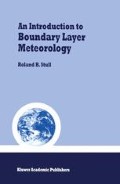Abstract
Turbulence is an intrinsic part of the atmospheric boundary layer that must be quantified in order to study it. The randomness of turbulence makes deterministic description difficult. Instead, we are forced to retreat to the use of statistics, where we are limited to average or expected measures of turbulence. In this chapter we review some basic statistical methods and show how measurements of turbulence can be put into a statistical framework. Usually, this involves separating the turbulent from the nonturbulent parts of the flow, followed by averaging to provide the statistical descriptor.
Access this chapter
Tax calculation will be finalised at checkout
Purchases are for personal use only
Preview
Unable to display preview. Download preview PDF.
References
André, J.-C., G. De Moor, P. Lacarrère, G. Therry, and R. du Vachat, 1978: Modeling the 24-hour evolution of the mean and turbulent structure of the planetary boundary layer. J. Atmos. Sci., 35, 1861–1883.
Bean, B.R. & T.P Repoff, 1983: A study of turbulent energy over complex terrain (STATE, 1978). Bound.-Layer Meteor., 25 17–23.
Caughey, S.J., J.C. Wyngaard and J.C. Kaimal, 1979: Turbulence in the evolving stable boundary layer. J. Atmos. Sci., 36, 1041–1052.
Richardson, L.F., 1922: Weather Prediction by Numerical Process. Cambridge Univ. Press.
Stull, R.B. and E.W. Eloranta, 1984: Boundary layer experiment — 1983. Bull. Am. Meteor. Soc., 65 450–456.
Van der Hoven, I., 1957: Power spectrum of horizontal wind speed in the frequency range from 0.0007 to 900 cycles per hour. J. Meteor., 14 160.
Van Dyke, M., 1982: An Album of Fluid Motion. The Parabolic Press, Stanford. 176 pp.
Author information
Authors and Affiliations
Editor information
Editors and Affiliations
Rights and permissions
Copyright information
© 1988 Kluwer Academic Publishers
About this chapter
Cite this chapter
Stull, R.B. (1988). Some Mathematical & Conceptual Tools: Part 1. Statistics. In: Stull, R.B. (eds) An Introduction to Boundary Layer Meteorology. Atmospheric Sciences Library, vol 13. Springer, Dordrecht. https://doi.org/10.1007/978-94-009-3027-8_2
Download citation
DOI: https://doi.org/10.1007/978-94-009-3027-8_2
Publisher Name: Springer, Dordrecht
Print ISBN: 978-90-277-2769-5
Online ISBN: 978-94-009-3027-8
eBook Packages: Springer Book Archive

